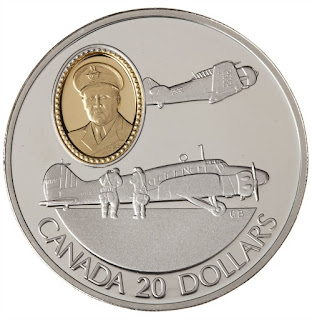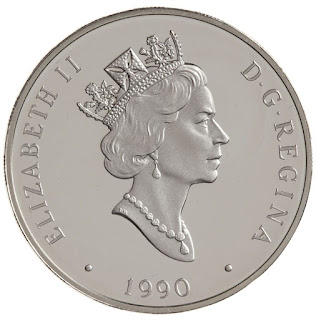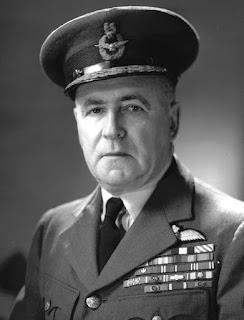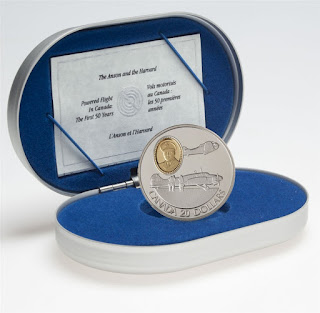Canada 20 Dollars Silver Coin 1990 The Anson and the Harvard
Avro Anson and North American Harvard
Powered Flight in Canada: The first 50 years
Obverse: Profile portrait of Her Majesty Queen Elizabeth II created in 1990 and notable for the grand jewelled tiara and a beautiful string of pearls, this royal effigy was designed by Canadian artist Dora de Pedery-Hunt.
Lettering: ELIZABETH II D · G · REGINA · 1990 ·
Reverse: Portrait of Air Marshal Robert Leckie in 24-karat gold-plated cameo. Two military pilots are ready to launch, near the aircraft on the ground. The machine on the ground is the Avro Anson, the aircraft in the air - Hanson (North American T6).
Lettering: CANADA 20 DOLLARS GB
Engraver: Geoff Bennett
Edge: Reeded & Plain Sections.
Diameter: 38 mm.
Weight: 31.103 g.
Material: Silver.
Fineness: 0.925.
Denomination: 20 Canadian Dollars.
Produced By: Royal Canadian Mint.
Air Marshal Robert Leckie
Air Marshal Robert Leckie (16 April 1890 Glasgow, Scotland – 31 March 1975 Ottawa, Canada) was a British-born Canadian aviation pioneer and Chief of the Air Staff of the Royal Canadian Air Force from 1944 to 1947.
First World War service
Leckie learned to fly in Toronto and joined the Royal Naval Air Service in 1915. During the First World War he flew anti-submarine patrols over the North Sea. Flying a Curtiss H12 flying boat on reconnaissance, Leckie downed the German zeppelin L22 near Terschelling on 14 May 1917. Fifteen months later, during a nighttime raid on 6 August 1918, a German zeppelin formation under the command of Führer der Luftschiffe (FdL.) (Admiral, 2nd class) Peter Strasser attacked Boston, Norwich, and the Humber estuary. Flying in a DH.4 biplane, Major Egbert Cadbury (pilot) and Leckie (gunner) took part in the interception engagement and were credited with downing Zeppelin L70 just north of Wells-next-the-Sea on the Norfolk coast. FdL. Strasser, head of the Imperial German Navy's zeppelin forces, was on board L70 and did not survive. By the end of the war, Leckie was a Wing Commander in the Royal Air Force (RAF).
Interwar years and Second World War service
Between the wars, he directed flying operations for the Canadian Air Board, and oversaw the creation of mail and passenger air service throughout Canada. He later returned to the RAF, and by 1940 commanded the British air forces in the Mediterranean Sea from Malta.
As the war expanded later that year, Leckie returned to Canada to take charge of training operations in Canada for the RAF. He was promoted to Acting Air Vice-Marshal in 1941, and was later made substantive. In 1942 he transferred to the Royal Canadian Air Force (RCAF). In 1944 he became Chief of Air Staff, and was promoted to Air Marshal. After his retirement from the RCAF, Leckie played an active role in the Canadian Air Cadet movement. He died in Ottawa on 31 March 1975.
Awards: Companion of the Order of the Bath, Distinguished Service Order, Distinguished Service Cross, Distinguished Flying Cross, Canadian Forces Decoration.
Avro Anson
The Avro Anson is a British twin-engined, multi-role aircraft that served with the Royal Air Force, Fleet Air Arm, Royal Canadian Air Force and numerous other air forces before, during, and after the Second World War. Developed from the Avro 652 airliner, the Anson, named after British Admiral George Anson, was developed for maritime reconnaissance, but found to be obsolete in this role. It was then found to be suitable as a multi-engined aircrew trainer, becoming the mainstay of the British Commonwealth Air Training Plan. By the end of production in 1952, a total of 8,138 had been built by Avro in nine variants, with a further 2,882 built by Federal Aircraft Ltd in Canada from 1941.
North American T-6 Texan
The North American Aviation T-6 Texan is a single-engined advanced trainer aircraft used to train pilots of the United States Army Air Forces (USAAF), United States Navy, Royal Air Force and other air forces of the British Commonwealth during World War II and into the 1970s. Designed by North American Aviation, the T-6 is known by a variety of designations depending on the model and operating air force. The United States Army Air Corps (USAAC) and USAAF designated it as the AT-6, the United States Navy the SNJ, and British Commonwealth air forces, the Harvard, the name it is best known by outside of the US. After 1962, US forces designated it the T-6. It remains a popular warbird aircraft used for airshow demonstrations and static displays. It has also been used many times to simulate the Japanese Mitsubishi Zero in movies depicting World War II in the Pacific.
British Commonwealth Air Training Plan
The British Commonwealth Air Training Plan (BCATP), often referred to as simply "The Plan", was a massive, joint military aircrew training program created by the United Kingdom, Canada, Australia and New Zealand, during the Second World War. BCATP remains as one of the single largest aviation training programs in history and was responsible for training nearly half the pilots, navigators, bomb aimers, air gunners, wireless operators and flight engineers who served with the Royal Air Force (RAF), Royal Navy Fleet Air Arm (FAA), Royal Australian Air Force (RAAF), Royal Canadian Air Force (RCAF) and Royal New Zealand Air Force (RNZAF) during the war.
Under a parallel agreement, the Joint Air Training Scheme, South Africa trained 33,347 aircrew for the South African Air Force and other Allied air forces. This number was exceeded only by Canada, which trained 131,500 personnel.
Students from many other countries attended schools under these plans, including Argentina, Belgium, Ceylon, Czechoslovakia, Denmark, Finland, Fiji, France, Greece, the Netherlands, Norway, Poland and the United States, where the similar Civilian Pilot Training Program was already underway by the end of 1938.
A Look Back- Faithful Annie - The Avro Anson
It is difficult to say which aircraft Canadians were most likely to see in the skies over Canada during World War II – the Harvard or the Avro Anson. Both were mainstays of the British Commonwealth Air Training Plan when large numbers of Commonwealth aviators, and even a few Americans, trained in this country. The plan also laid the foundation for similar activities with NATO air forces starting in the 1950s.
Like the Harvard, the Anson was originally a foreign aircraft, having been designed in Britain in the 1930s, but unlike the Harvard its initial purpose was as a commercial airliner. It had little success in that role, and with the approach of war in the late 1930s it took on a military presence in the guise of a reconnaissance bomber and training aircraft.
Although it did some work early in the war in antisubmarine patrols, it was patently obsolete by that time. To illustrate, the story is told of an Anson that attacked a British submarine by mistake. It dropped some bombs on the sub; the result was to break four light bulbs.
When the first Ansons were employed in Canada under the BCATP they were aircraft hurriedly sent from Britain, some with bullet holes still visible in the fuselage and the mid-upper turret still in place. The holes were plastered over and the turret was removed soon after the aircraft reached Canadian airfields.
Although the aircraft was underpowered it was reliable, and such was the demand for it in the training role that production was soon transferred to Canada where it was carried out until the end of the war. More than 2,800 Ansons were produced here, the last version to leave the assembly line being the Mark V. This version differed from the original in having more powerful engines, but the chief improvement was a switch from fabric to moulded plywood; this gave it improved performance and, as one observer put it, “cut down on the number of drafts.” This Mark V served not only during the war but afterwards; the last one was retired in 1954.
Its stability and reliability earned it the appellation of ‘Faithful Annie.’ It was very much the right aircraft at the right time for training badly needed aircrew.
Canadian Coins
Canada 20 Dollars Silver Coin 1990 The Anson and the Harvard



